Tweezing. Tweezing is the most inexpensive technique of removal, and is normally considered appropriate for eyebrows, so that you may need to adjust their shape once in a while and allow the hairs to grow back. However, tweezing can cause scar tissue to form and also can stimulate the hairs to grow thicker and coarser. Avoid the use of tweezers on sparse facial hair or as a manner of disposing of big areas of undesirable hair at the legs and underarms.
Shaving. The problem with shaving for women is that they may have stubble, which is socially and culturally unacceptable. Shaving can cast off hair without stimulating the roots. And if the goal is to completely eliminate the hair, shaving is a better alternative than waxing, or tweezing if you’re having electrolysis treatment because of the potential skin damage related to these techniques.
Waxing. Waxing is essentially huge scale tweezing. It gets rid of the hair for long periods of time without generating stubble. With the exception of hair that has been hormonally stimulated, hair is waxed on regions which include the lower leg or underarm. However, like tweezing, waxing can negatively stimulate the roots and hair follicles on areas like the chin, breast, abdomen, and upper lip.
Threading. This is an ancient approach popular in places like India and the Middle East. It entails the use of a normal thread to take away hair from the surface of the skin.
Hair Removal Creams. These lotions (also referred to as depilatories) get rid of surface hair but they generally tend to have much less impact at the follicle than methods like tweezing.
Sugaring. Sugaring can create the same effects as waxing; however, doesn’t require much heating. It can be messy and, as a result, isn’t always handy. It is also a large-scale tweezing technique.
Home Electrolysis Kits. They can “tweeze” out the hairs rather than getting rid of them via electrolysis.
Laser. Laser remedy for hair elimination is gaining reputation, but its fulfillment is truly dependent on the hair and skin pigment.
Electrolysis. Electrolysis is the simplest permanent manner of eliminating hair, however it does require dedication. The electrologist uses a filament or needle, putting it along the hair shaft and into the hair follicle. A moderate electric cutter then destroys the hair-growing cells inside the follicle.


